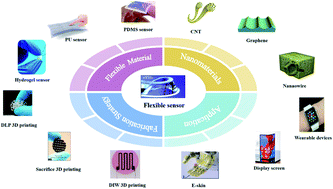Emerging flexible sensors based on nanomaterials: recent status and applications
Abstract
Flexible sensors have received tremendous attention over the last several decades due to their outstanding properties, such as high stretchability, excellent biocompatibility, great conformability, and low cost. The main fatal aspect of flexible sensors is that the flexible material has poor conductivity, resulting in obtained flexible sensors possessing poor sensitivity. Many kinds of nanomaterials with excellent conductivity have been integrated with flexible materials to improve the conductivity of flexible sensors, such as carbon nanomaterials and metal nanomaterials. In terms of molding, 3D printing serves as an ideal technology for producing flexible sensors because it can generate previously unattainable geometric structures compared with traditional fabrications. Understanding the features of flexible materials, nanomaterials, and 3D printing technology, and assessing the possibility of their fabrication are therefore critical for the development and application of flexible sensors. Herein, we review the recent literature on flexible materials and nanomaterials, and the fabrication strategy of flexible sensors, with a particular focus on stretchable and self-healing properties. Then, we discuss the application of flexible sensors, such as biomedical devices, wearable devices, and soft robots. Finally, we provide key challenges and opportunities that lie ahead for flexible sensors.

- This article is part of the themed collection: Journal of Materials Chemistry A Recent Review Articles


 Please wait while we load your content...
Please wait while we load your content...